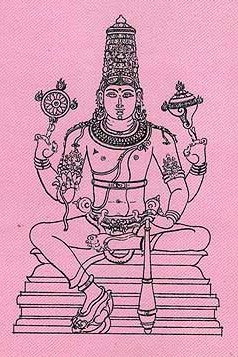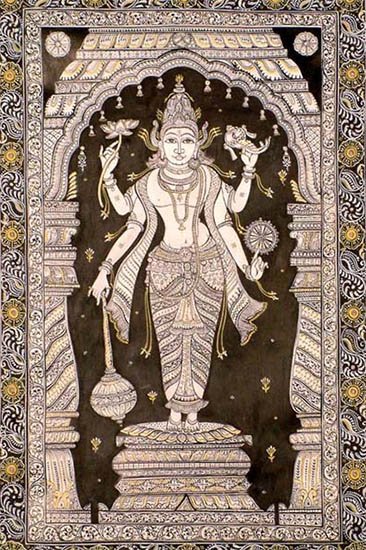Arca, Arcā, Ārca: 19 definitions
Introduction:
Arca means something in Hinduism, Sanskrit, the history of ancient India, Marathi, Hindi. If you want to know the exact meaning, history, etymology or English translation of this term then check out the descriptions on this page. Add your comment or reference to a book if you want to contribute to this summary article.
Alternative spellings of this word include Archa.
Images (photo gallery)
In Hinduism
Pancaratra (worship of Nārāyaṇa)
Source: archive.org: Isvara Samhita Vol 1Arcā (अर्चा) refers to the fifth of the five-fold manifestation of the Supreme Consciousness the Pāñcarātrins believe in.—Arcā means a worshippable image (also, the worship). For the followers of the Pāñcarātra, arcā is not an inanimate piece of stone. They treat it as a living and sentient being, since life energy (prāṇa) has been infused into it through the ceremony of Prāṇapratiṣṭhā.
Source: SriMatham: Vaiṣṇava Iconology based on Pañcarātra Āgama1) arca—Sanskrit term meaning 'object of adoration and worship' and used in hindu iconology (e.g. the Āgamas).
2) When a stone image (bera) is fashioned according to the principles laid down in the Agama, and is consecrated according to the rules and rites, then the Supreme Being by dint of His omnipotence and Omnipresence is capable of descending into such an icon with a tiny ray of His Potency (Śakti) in a subtle body known as a "divya maṅgala vigraha". This is technically known as the Arca Avatāra or Iconical descent in which the Lord manifests Himself out of compassion for the embodied beings in order to bestow His blessings upon them and to receive their offerings.
These Icons are said to be of three types;
- Svayam vyakta—Self manifested; uncreated by human hands.
- Purva sthāpita—Those established and worshipped ma ny years ago by great sages and gods.
- Pratiṣṭhita—And those presently established by wealthy Beings.

Pancaratra (पाञ्चरात्र, pāñcarātra) represents a tradition of Hinduism where Narayana is revered and worshipped. Closeley related to Vaishnavism, the Pancaratra literature includes various Agamas and tantras incorporating many Vaishnava philosophies.
Shilpashastra (iconography)
Source: Wisdom Library: Śilpa-śāstraArcā (अर्चा) is a Sanskrit word referring to an “object of adoration and worship”. It is used throughout texts and practice of Hindu iconology.
Source: Shodhganga: The significance of the mūla-beras (śilpa)Arcā (अर्चा) refers to a classification of Hindu images, as defined in the texts dealing with śilpa (arts and crafs), known as śilpaśāstras.—Images are classified into five forms, namely parama, vyūha, vibhāva, antaryāmi and arcā. Arcā stands for images that are worshipped, which have been fashioned according to the specifications and methodology of the sculptural tradition. It is only through the arcā state that He becomes perceptible and manifest in a form which can be identified and worshipped by all.

Shilpashastra (शिल्पशास्त्र, śilpaśāstra) represents the ancient Indian science (shastra) of creative arts (shilpa) such as sculpture, iconography and painting. Closely related to Vastushastra (architecture), they often share the same literature.
Purana and Itihasa (epic history)
Source: Cologne Digital Sanskrit Dictionaries: The Purana IndexArcā (अर्चा).—Of Hari. Worship of Hari's image is said to promote one's welfare. Some special places devoted to. This form is prevalent even in tretā yuga;1 to be worshipped in the payovrata.2 arcā is rājasa. Mere idol worship condemned. When proper;3 arcā may be of gold, silver, of earth or water or other substance.4 upāsanā of, a means to concentration on the Absolute.5 Worship may be offered on the ground, fire, sun, waters, Brāhmaṇa or any other thing. Image of eight kinds including stone, wood and metal; may be moveable or immoveable. The mode in worship. Subsidiary worship to the ornaments, implements and attendants on Hari. Founding a shrine, flowergarden and instituting festivals form part of the worship.6 Only people of little tapas are engaged in arcā, this being regarded inferior to worshipping Brahman.7
- 1) Bhāgavata-purāṇa VII. 14. 28-40.
- 2) Ib. VIII. 16. 28.
- 3) Ib. III. 29. 9, 21-25
- 4) Ib. IV. 8. 56.
- 5) Ib. XI. 20. 24.
- 6) Ib. XI. 27. 9-43,
- 7) Ib. X. 84. 10; 86. 55.

The Purana (पुराण, purāṇas) refers to Sanskrit literature preserving ancient India’s vast cultural history, including historical legends, religious ceremonies, various arts and sciences. The eighteen mahapuranas total over 400,000 shlokas (metrical couplets) and date to at least several centuries BCE.
Yoga (school of philosophy)
Source: ORA: Amanaska (king of all yogas): A Critical Edition and Annotated Translation by Jason BirchArcā (अर्चा) refers to the “practice of Śaiva worship”.—The Siddhasiddhāntapaddhati teaches the ideal of the Avadhūtayogin who transcends all practices, including yoga. This central teaching of the Nāths is absent in the Śivayogadīpikā, which posits the practice of Śaiva worship (arcā) and yoga as the chief means to liberation. Therefore, it is more likely that their parallel passages stem from a third source and that the description of both texts as a siddhasiddhāntapaddhati was fortuitous.

Yoga is originally considered a branch of Hindu philosophy (astika), but both ancient and modern Yoga combine the physical, mental and spiritual. Yoga teaches various physical techniques also known as āsanas (postures), used for various purposes (eg., meditation, contemplation, relaxation).
India history and geography
Source: Shodhganga: a concise history of Sanskrit Chanda literature (history)Arcā (अर्चा) is the name of a work ascribed to Āśādhara (1178-1243 C.E.) according to the “New Catalogus Catalogorum” II. pp. 194-96. Āśādhara was a famous Jain author belonging to the Sapādalakṣa country where Śākambharī is situated and composed many works (viz., the Arcā).
Source: Cologne Digital Sanskrit Dictionaries: Indian Epigraphical GlossaryĀrcā.—(EI 24), the image of a god; cf. arcā, adoration. Note: ārcā is defined in the “Indian epigraphical glossary” as it can be found on ancient inscriptions commonly written in Sanskrit, Prakrit or Dravidian languages.

The history of India traces the identification of countries, villages, towns and other regions of India, as well as mythology, zoology, royal dynasties, rulers, tribes, local festivities and traditions and regional languages. Ancient India enjoyed religious freedom and encourages the path of Dharma, a concept common to Buddhism, Hinduism, and Jainism.
Languages of India and abroad
Marathi-English dictionary
Source: DDSA: The Molesworth Marathi and English Dictionaryarcā (अर्चा).—f (S) Worship, adoration, homage. 2 An idol-image. 3 Also arcāśuddhi f (S) The ceremony of purifying an image from the hands of the maker and of summoning the numen or divinity to reside in it: also renewed purification of an idol from any defilement contracted.
Source: DDSA: The Aryabhusan school dictionary, Marathi-Englisharcā (अर्चा).—f Worship, adoration.
Marathi is an Indo-European language having over 70 million native speakers people in (predominantly) Maharashtra India. Marathi, like many other Indo-Aryan languages, evolved from early forms of Prakrit, which itself is a subset of Sanskrit, one of the most ancient languages of the world.
Sanskrit dictionary
Source: DDSA: The practical Sanskrit-English dictionaryArca (अर्च).—a. Ved. Shining; अस्मा एतद् दिव्यर्चेव मासा (asmā etad divyarceva māsā) Ṛgveda 6.34.4.
--- OR ---
Arcā (अर्चा).—[arc-aṅ]
1) Worship, adoration; अर्चायामेव हरये पूजां यः श्रद्धयेहते (arcāyāmeva haraye pūjāṃ yaḥ śraddhayehate) Bhāgavata 11.2.47.
2) An idol or image intended to be worshipped; मौर्यैर्हिरण्यार्थिभिरर्चाः प्रकल्पिताः (mauryairhiraṇyārthibhirarcāḥ prakalpitāḥ) Mahābhārata 5.3.99. (there is some dispute among scholars as to the precise meaning of this passage); अर्चापूजा- प्रतिमयोः (arcāpūjā- pratimayoḥ) Nm.
--- OR ---
Ārca (आर्च).—a. (-rcī f.) [अर्चा अस्त्यस्य ण (arcā astyasya ṇa) P.V.2.11]
1) Devout, worshipping, pious.
2) Relating to the Ṛik or Ṛgveda.
Source: Cologne Digital Sanskrit Dictionaries: Shabda-Sagara Sanskrit-English DictionaryArcā (अर्चा).—f.
(-rcā) 1. Worship, see arcana. 2. An image. E. arca to worship, ac affix, and ṭāp fem. do.
Source: Cologne Digital Sanskrit Dictionaries: Benfey Sanskrit-English DictionaryArcā (अर्चा).—[arc + ā], f. Worship,
1) Arcā (अर्चा):—[from arc] f. ([Pāṇini 2-3, 43 and 2, 101]) worship, adoration, [Śatapatha-brāhmaṇa xi; Manu-smṛti] etc.
2) [v.s. ...] an image or idol (destined to be worshipped), [Varāha-mihira’s Bṛhat-saṃhitā] etc.
3) [v.s. ...] body, [Jaina literature]
4) Ārca (आर्च):—1. ārca mfn. ([from] arcā, [Pāṇini 5-2, 101]) = arcāvat (q.v.), worshipping, doing homage.
5) 2. ārca mf(ī)n. ([from] ṛc), relating to the Ṛc or Ṛg-veda.
Source: Cologne Digital Sanskrit Dictionaries: Yates Sanskrit-English Dictionary1) Arca (अर्च):—(ña) arcayati te 10. c. Idem.
2) Arcā (अर्चा):—(cā) 1. f. Idem.
Source: DDSA: Paia-sadda-mahannavo; a comprehensive Prakrit Hindi dictionary (S)Arcā (अर्चा) in the Sanskrit language is related to the Prakrit word: Accā.
[Sanskrit to German]
Sanskrit, also spelled संस्कृतम् (saṃskṛtam), is an ancient language of India commonly seen as the grandmother of the Indo-European language family (even English!). Closely allied with Prakrit and Pali, Sanskrit is more exhaustive in both grammar and terms and has the most extensive collection of literature in the world, greatly surpassing its sister-languages Greek and Latin.
Hindi dictionary
Source: DDSA: A practical Hindi-English dictionaryArcā (अर्चा) [Also spelled archa]:—(nf) see [arcana].
...
See also (Relevant definitions)
Starts with (+40): Arca-desha, Arcabera, Arcabhin, Arcabu, Arcaddhuma, Arcagriha, Arcaka, Arcakashabdotpatti, Arcakatva, Arcaki, Arcakridana, Arcala, Arcana, Arcana-bhoga, Arcana-vibhava-kani, Arcana-vritti, Arcanadhikara, Arcanadi, Arcanaiyati, Arcanamani.
Ends with (+102): Abhyarca, Adakharca, Adhyayanavidhicarca, Adrishtakharca, Amdani-kharca, Anadhikaracarca, Ardharca, Ashtadasharca, Ashtarca, Atithyarca, Ativarca, Aucityavicaracarca, Bajekharca, Barca, Barkhe-kharca, Batokharca, Birihadakharca, Buditakharca, Calarca, Carca.
Full-text (+36): Arcana, Arcavat, Arcis, Acca, Arcanas, Arcavidhi, Dirghanasiky-arca, Arcas, Vishvatryarcas, Arvananas, Arcya, Arca-desha, Arccai, Arcarha, Arcita, Agama, Arcavidambana, Arcaka, Arcaniya, Arcarhaka.
Relevant text
Search found 23 books and stories containing Arca, Arcā, Ārca, Ārcā; (plurals include: Arcas, Arcās, Ārcas, Ārcās). You can also click to the full overview containing English textual excerpts. Below are direct links for the most relevant articles:
Garga Samhita (English) (by Danavir Goswami)
Verse 1.14.48 < [Chapter 14 - The Liberation of Śakaṭāsura and Tṛṇāvarta]
Verses 8.10.20-21 < [Chapter 10 - The Paddhati and Paṭala of Lord Balarāma]
Verse 6.10.2 < [Chapter 10 - In the Description of the Gomatī River, the Glories of Cakra-tīrtha]
Rig Veda (translation and commentary) (by H. H. Wilson)
Hari-bhakti-kalpa-latikā (by Sarasvati Thkura)
Text 8 < [Second Stabaka]
Tiruvaymoli (Thiruvaimozhi): English translation (by S. Satyamurthi Ayyangar)
Pasuram 8.6.2 < [Section 6 - Sixth Tiruvaymoli (Elliyum kalaiyum)]
Pasuram 3.5.8 < [Section 5 - Fifth Tiruvaymoli (Moym mam pum polil)]
Introduction to Section 6.1 < [Section 1 - First Tiruvaymoli (Vaikal pun kalivay)]
Isha Upanishad (by A.C. Bhaktivedanta Swami Prabhupada)
Chaitanya Bhagavata (by Bhumipati Dāsa)
Verse 2.27.48 < [Chapter 27 - The Lord Pacifies Feelings of Separation]
Verse 3.2.277 < [Chapter 2 - Description of the Lord’s Travel Through Bhuvaneśvara and Other Placesto Jagannātha Purī]
Verse 3.2.305 < [Chapter 2 - Description of the Lord’s Travel Through Bhuvaneśvara and Other Placesto Jagannātha Purī]
Related products

